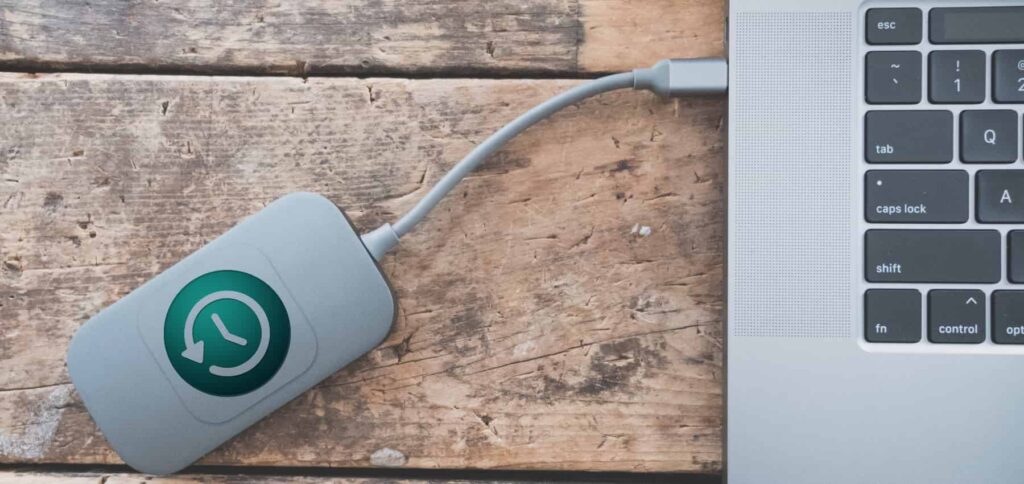With Time Machine, your Mac has a built-in way to automatically save snapshots of your files, settings, apps, and system at regular intervals. You can hook up any external storage device that functions with your Mac via USB, Thunderbolt, or FireWire and utilize it as a backup destination. Alternatively, you can furthermore pick a network-attached storage (NAS) device or another Mac that is shared as a Time Machine backup location.
Using Time Machine with an external hard drive is like having a safety net for everything you do on your Mac. If your Mac ever cracks down, you can quickly restore your system from a Time Machine backup. You can also use a Time Machine backup to go back to a previous version of macOS without losing your apps and data. Time Machine is also handy for daily file backup. You can retrieve individual files you have erased or undo changes to a file by going back to an earlier saved state.
In this article, we will walk you through the steps to set up Time Machine on your Mac in macOS Ventura and show you how to initiate a backup whenever you like.

A Guide to Backing Up Your Mac Using Time Machine in macOS Ventura
Follow the guide step-by-step to successfully back up your Mac with a time machine.
link your Mac to the Time Machine backup drive
To start a Time Machine backup plug in your chosen external storage to your Mac computer. Keep in mind that this storage can only be used for Time Machine backups. And not for other files because Apple will essentially designate the SSD to Time Machine solely. Apple suggests that the backup disk should have at least double the size of the system you want to back up. But don’t worry if your external disk runs out of storage space before finishing a full backup you will get a notification.
Also Read- How To Back Up Your Google Hangouts Data
Choose a Backup Destination
Time Machine is a built-in backup feature in macOS that automatically backs up your Mac. To utilize Time Machine, you require to choose a backup destination. There are three options for backup destinations: an external drive connected to your Mac, a network-attached storage (NAS) device that supports Time Machine over SMB, or another Mac shared as a Time Machine backup destination.
1. External Drive Connected to Your Mac
- Connect an external drive to your Mac through USB, Thunderbolt, or FireWire port.
- If Time Machine catches that the disk isn’t using the correct format, it will prompt you to erase it.
2. Network-attached Storage (NAS) Device
- Check the documentation for your NAS device to see if it supports Time Machine over SMB.
- If it does, connect the NAS device to your network.
- In Time Machine preferences, choose the NAS device as the backup destination.
3. Mac Shared as a Time Machine Backup Destination
- Make sure the Mac running macOS Ventura or later is available for Time Machine backup.
- Go to System Settings and select General > Share.
- Turn on File Sharing and enter your administrator password.
- Click the info option next to File Sharing.
- Click the add button (+) under Shared Folders and choose a folder for Time Machine backups.
- Right-click the folder and select Advanced Options.
- In the advanced options select Share as a time machine backup location and then tap on ok.
- The shared folder can now be used as a backup device for additional Mac computers running Time Machine.
Also Read- [Guide] How To Back Up Your PS5 Data
setup and configure Time Machine backups
After connecting your preferred external storage device to your Mac, either through a network or by employing a USB-C cable or similar, you can move forward to access the Time Machine settings. Apple will prompt you to select the specific disk that you like to use for Time Machine backups.
- You need to tap on the Apple menu in the top left corner of your screen.
- After that, you need to select System Preferences from the drop-down menu options.
- In the System Preferences window, click on “General” in the sidebar on the left.
- On the right side of the General panel, you’ll see an option for “Time Machine“. Click on it.
- In the Time Machine settings choose your external storage device as the backup location. In macOS Ventura or later you can do this by clicking the + and following the steps that appear on the screen.
- When your external storage is recognized by the Apple Time Machine app you can choose the system to initiate a backup manually without having to wait for the next scheduled backup. After that, Time Machine will automatically make regular backups for you.
Also Read- How To Back Up BitLocker Recovery Key In Windows 11
check the status and the last backup
You can always check the status and the last backup done by clicking on the Time Machine menu icon which looks like a circular arrow clockface. When you click on it, it will show you the status of a current backup in progress. Or inform you when the prior backup concludes. This way, you can be sure that all your documents remain securely stored on the external drive.
Backup Frequency of Time Machine
Time Machine in macOS performs automatic backups every hour for the past 24 hours. Also, daily for the past month, and weekly for all previous months. Older backups delete when the backup disk is full. The macOS Ventura allows users to change backup frequency through Time Machine settings. The initial backup may take some time. But future backups will be faster as Time Machine only backs up modified files.
Also Read- How to Back Up Your iPhone
Conclusion
In conclusion, Time Machine is a strong backup tool that comes with macOS Ventura, which can protect your crucial files and data. Whether you choose to utilize an external drive, network-attached storage device, or another Mac on your network, Time Machine makes it effortless to conduct routine backups.
Also Read- Steps For Backup And Restore Quick Settings In Windows 11





































